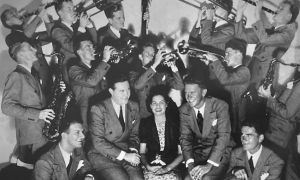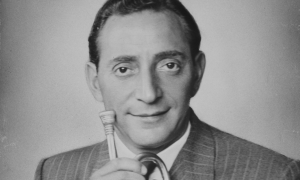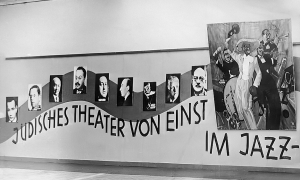Home » Jazz Articles » History of Jazz » Pilar Arcos: An Extraordinary Life
Pilar Arcos: An Extraordinary Life

Arcos' DNA was architectured in the entertainment world; her Spanish father, Manuel Pubillones-Diaz owned the famous Gran Circo Pubillones and her mother, Pilar Guallart, known as "La Bella Geraldine," was a trapeze artist and dancer. The Arcos' family was large—she had 7 sisters (one of which died in childbirth on the family's kitchen floor and which was witnessed by Pilar as a young child). Later, as a youth in Spain, Arcos, a talented but already precocious child, was expelled from her convent school for her rather unique musical interpretations of religious hymns. She then had formal musical training at the Conservatory in Madrid where she excelled in sight-reading, a skill which would hold her in good stead throughout her recording career. Señor Pubillones died in 1910 and shortly thereafter the Pubillones family left Spain for the "gilded streets" of the United States.
At the genesis of the 20th century, there was a massive influx of Latino population into New York from Puerto Rico and Cuba, since both islands—no longer under Spanish rule -were under the aegis of the U.S. government. Pilar emigrated to New York and in her teens looked for performing work. She then met and fell in love and in 1919 married Guillermo Arcos, a guitarist, music teacher, and occasional actor whose best acting work was in 1934's Cuesta Abajo with tango artist, Carlos Gardel (a friend and somewhat of a mentor to Astor Piazzolla when Piazzolla lived in the U.S.). The Arcos' marriage would later dissolve. It is unknown if a divorce was ever finalized.
At this time in the mid-'20s, the music recording and movie industries and their technologies were emerging. Sheet music and piano rolls were on the demise. Edison's phonograph had enabled music lovers to enjoy music in their homes without the need for player-pianos. Radios were appearing in more homes. Arcos, ever the assertive one, would trek to recording studios searching for opportunities to sing. She made her recording debut in 1919 when she recorded "Fado Blanquita" and "Que será, que no sera" for Columbia Records. Having a marvelous soprano voice and the ability to sight-read music exceptionally well, her singing career skyrocketed. Record labels such as Vocalion/Brunswick, Decca, Okeh, and Columbia saw the potential for record sales to the burgeoning Hispanic market. Pilar leaped at the opportunity, travelling from studio to studio to record a wide variety of songs—zarzuelas, foxtrots, and tangos—with orchestras and in duets with Fortunio Bonanova, Jose Moriche. Rodolfo Hoyos, and others.
Between before 1920 and 1933, Arcos recorded nearly three hundred selections for these labels. It was believed that she was the most frequently recorded musical artist in 1927. Many Arcos recordings were novelty ("Soy Virgencita," translated as "I'm a Virgin") or "ditty" tunes ("Valentino," Mi Saxofón, and the unique, "La Cocaina," a tale of a jilted lover who takes her solace in cocaine and champagne). Many other tunes she recorded could be defined as Jazz Age songs ("Oida, Oida," a Spanish-translated version of Bob Carlton's jazz hit, "Ja-Da," and "Taxi ... Taxi ..."). Although unverified, it is believed that Arcos' version of "Alla en Rancho Grande" with Juan Pulido was the song's very first recording (it was later a hit for Bing Crosby, et al).
Many of her recordings were with fine New York orchestras such as those led by Louis Katzman. A Russian-Jewish immigrant cornetist/trumpeter largely forgotten today, Katzman had already established himself in the music business early on as Thomas Edison's pianist and arranger. He was well-known in vaudeville and Broadway as both a player and arranger. His recording "bands," operating under over 50 different names (e.g., "Los Castilians," "The Floridians," "Orquestra Tipica," et al.), are featured on many of Arcos' efforts, and, given Katzman's celebrated status in town, the orchestras under his baton included some of New York's finest musicians, among them were the Dorseys, Miff Mole, Mannie Klein, and many others. Latin legend, Xavier Cugat was also a regular violinist in Katzman's ensembles. Never involved romantically with "Cugie," Arcos would later quip: "I'd have nothing to do with Cugat and his disgusting Chihuahuas!"
Although there are no notated citations, it was known that Arcos also performed on and recorded via live radio recordings direct-to-disc during this period. Arcos, expanding her performance skill set, also took Spanish dance lessons (flamenco, etc.) with esteemed instructor, Francisco "Paco" Cansino, he of the famous "Dancing Cansinos" from Spain. In addition to Pilar, Cansino's students during that time included his niece, Margarita Carmen Cansino—later known as actress "Rita Hayworth" -and also the legendary Puerto Rican-born dancer/actress, Rita Moreno. Pilar, a featured performer, danced, acted and sang live in many New York area theaters, including the Lyric Theater and the very famous Daly's Theater on 63rd Street Manhattan which had opened for business in 1921 with Eubie Blake's "Shuffle Along" (which was orchestrated by the aforementioned Louis Katzman) and in 1926 would offer Mae West's controversial production, Sex). Daly's regularly featured Pilar offering zarzuelas (sing-speaking shows also known as "Spanish operas"). She also performed extensively at the legendary Apollo Theater on 125th Street. Both were then key venues for Hispanic productions, performers, and growing Latin audiences.
On November 5, 1922, Arcos' Teatro Lírico Español show opened at Daly's and dominated the theater's offerings through March 1924. Arcos' ensemble would also tour in Philadelphia, in Bayonne, New Jersey, and in other Mid-Atlantic cities. Later her Compania de Zarzuelas returned to Daly's to rave reviews and where it ran for a year. Arcos' fans were ardent about her that they would write letters to the Spanish-language newspaper, La Prensa requesting songs for her to perform in her shows. She later appeared on Broadway in the play Adam Had Two Sons (playing "the Fat Girl") in 1932. It was there that Pilar met another actor, interestingly stage-named "Fortunio Bonanova." Bonanova's real name was José Lluis Moll-Esteva. A strikingly handsome Spaniard singer-actor, he had already performed in opera (Tannhäuser) in Spain and had already lead-acted there in the Baños Brothers' silent film Don Juan Tenorio in 1921. He would direct his own version of that tale in 1924. In 1926, Arcos formed a performing company in the U.S. with Bonanova. They would tour extensively throughout Cuba, Mexico, and in Spain and would later be romantically involved and live together. When the Spanish Civil War escalated, the couple, then performing in Spain and soon seeing their property confiscated, returned to the United States. Bonanova also generously paid for Pilar's entire Spanish family to travel by boat to New York, with one daughter, Martha Arcos, leaving from Genoa, Italy. (She was there hiding out in a Pirelli Tire factory.)
As the movie business when from silent to sound, it gravitated from New York to the sunshine of California. And, having a desire to develop a movie career, Arcos and Bonanova relocated to Los Angeles in the 1930s. While in Los Angeles, Arcos and Bonanova found plenty of diverse work. They were part of a growing number of Hispanic artists in the entertainment world and that circle generated opportunities for all. She became friends with Ricardo Montalban, Gilbert Roland, and Cesar Romero. Forming a singing academy in Los Angeles with Bonanova, Arcos also taught singing and was a vocal coach to W.C. Fields' girlfriend, Carlotta Monti (her birth name was Montijo) who wanted to sing opera. She even did uncredited stunt work in films. Pilar did voice-over Spanish dubbing work for many well-known films -Judy Garland's "Easter Parade," for example. Bonanova himself went on to an illustrious acting career in such films as "Citizen Kane," "For Whom the Bell Tolls," "Blood and Sand," et al. Arcos eventually discovered that Bonanova was having an extra-marital affair and that relationship ended. However, Bonanova would remain a family friend for the remainder of his life.
Pilar's first acting role in Hollywood—uncredited—was as a gypsy in the 1937 film, The Firefly. In 1938, she received her first screen credits acting in Castillios in el aire and in Verbena trágica. Her screen presence, built from years of theatrical and live performance work, and with her still very attractive looks, led her to roles in many television shows (Rawhide, Kraft Suspense Theatre, Death Valley Days, et al) and other movies (El otro soy yo, El Rancho del pinar). She played "Lucy's" mother-in-law's friend in a hilarious I Love Lucy episode ("Lucy's Mother-in-Law," Season 4, Episode 8—November 22, 1954) along with Rodolfo Hoyos and also with Fortunio Bonanova playing a fake mind-reading magician in a "bridge the language gap" act with "Ricky."
The musical and entertainment thread running through the Arcos Family saga resonated on during this time. Arcos' daughter, the previously mentioned Martha, married singer Tomás Cornejo, a suave, drop-dead handsome Mexican. She met him when Cornejo was performing with her father, Guillermo Arcos in the Bay Area. It was her second marriage. Her first was to trumpeter, Maurice "Maury" Harris who graced the trumpet section of Johnny Carson's Tonight Show for decades. The progeny of that marriage to Cornejo yielded Yolee Hyde, wife of the late "Wrecking Crew" and first-call studio trombonist, "Slyde" Hyde and Zelee Findley, wife of trumpeter Chuck Findley, who is believed to be the world's most recorded trumpeter. Daughter Yolee took up the entertainment vocation and sang back-up vocals in Los Angeles on various sessions. She also acted in two films and was managed by none other than "Dead End Kid," Huntz Hall. Interestingly, Yolee met Slyde on a movie set and sealed that romantic deal when she encountered Hyde performing at Donte's jazz club. A studio recording session and a come-along-for-the-trip led to the Zelee-Chuck Findley romance and later, marriage. As time went on and Arcos grew older, her musical spirit never waned. She acted in a play at 89 years old and she would sing and play piano and encourage impromptu jam sessions with the talented Hyde and Findley families.
Pilar Arcos, a legend certainly deserving greater notoriety, died in Los Angeles on January 10, 1990.
From a circus child to Broadway and to the glamour and heights of Hollywood, the Arcos saga is a tale of passion, flair, elegance, and certainly a supreme and sublime talent. A mold-breaker of extraordinary achievements, her legend will live on as a model for Latina and all women artists—and yes, us men, as well.
This article is dedicated to the memory of Martha Arcos, "Slyde" Hyde, and Derek Findley.
Photos courtesy: Yolee Hyde Article Research Assistant: Amy E. Mondello
Tags
PREVIOUS / NEXT
Support All About Jazz
 All About Jazz has been a pillar of jazz since 1995, championing it as an art form and, more importantly, supporting the musicians who make it. Our enduring commitment has made "AAJ" one of the most culturally important websites of its kind, read by hundreds of thousands of fans, musicians and industry figures every month.
All About Jazz has been a pillar of jazz since 1995, championing it as an art form and, more importantly, supporting the musicians who make it. Our enduring commitment has made "AAJ" one of the most culturally important websites of its kind, read by hundreds of thousands of fans, musicians and industry figures every month.






















